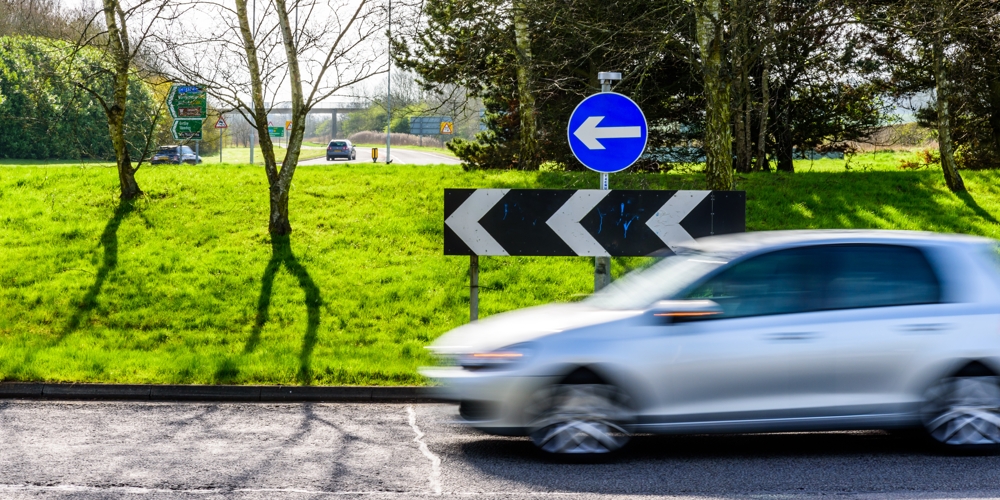
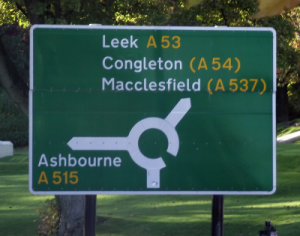 As roads have become busier, the design of junctions has changed. There are now roundabouts in many places where there used to be crossroads.
As roads have become busier, the design of junctions has changed. There are now roundabouts in many places where there used to be crossroads.
Roundabouts come in many shapes, sizes and configurations. They improve traffic flow by allowing streams of traffic to filter together.
In this lesson, you will learn how to approach large and mini-roundabouts using the now familiar hazard routine.
The lesson covers most of the roundabout types you will come across in your lessons and, depending on where you live, more besides.
In theory, roundabouts should be easier to deal with than other junctions you have dealt with so far because traffic is only coming from one direction - the right. However, you will need to sharpen up your decision-making skills to 'join the flow' successfully.
The secret of making roundabouts easy is to act early, look for gaps, and decide which vehicle you will follow (more about that later).
Your instructor will probably suggest that you start your roundabout practise on quiet, straightforward roundabouts. Later you will tackle busier and more complex systems, possibly controlled by traffic lights or not fitting the usual rules. But let's take this one step at a time for now!
If you live near Swindon in Wiltshire, you might even tackle the 'Magic roundabout' covered at the end of this lesson.
You can see more roundabout videos in the Driving Test Success practical driving app. (Google Play | App Store - appstore practical videos available as an in app purchase in the 4 in 1 kit)
Your driving test examiner with not mark roundabouts specifically on the driving test report form. They are marked under the 'junctions' section of the form. If you make a significant mistake at a roundabout, the examiner will explain the problem in the end-of-test debrief.
Examiners consider how you approach and deal with roundabouts the same way as they do at other junctions.
There is also an element of eco-driving to consider at roundabouts.
With good planning, it is often possible to keep the car moving; this is more eco-friendly than stopping every time.
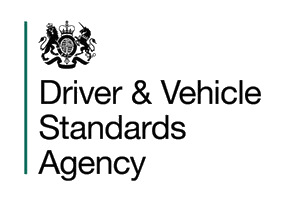
The examiner will look for:
A routine approach (the hazard routine)
Correct speed and positioning
Correct signal use
Lane discipline - selecting and maintaining an appropriate lane
Effective observation
Anticipation of other road users
These are some typical and less typical roundabout signs...
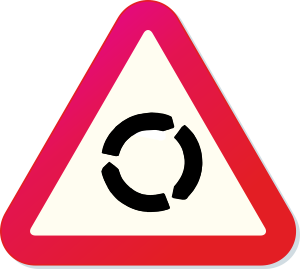
Warning - roundabout ahead. This sign is placed on
approach to the roundabout
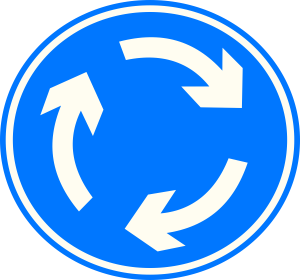
Mini roundabout - this is a mandatory sign which
indicates that you must go around the island/marking.
This sign is located at the mini-roundabout.
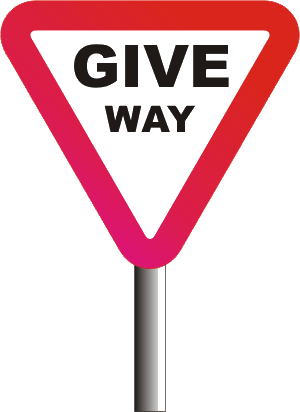
Give way signs are placed at some roundabouts
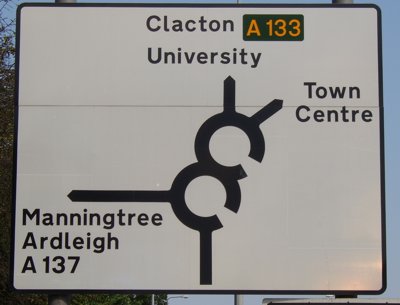
A direction sign showing a double roundabout ahead
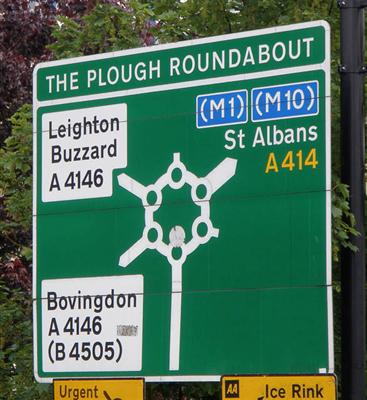
This sign and the sign below show junctions with multiple
mini-roundabouts around a central island
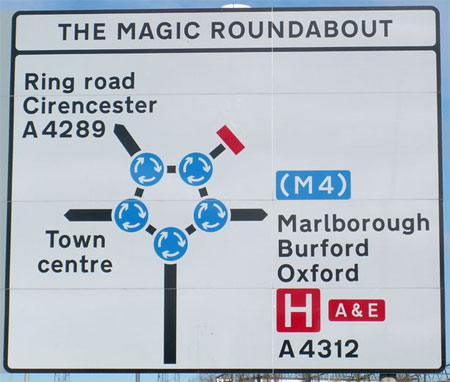
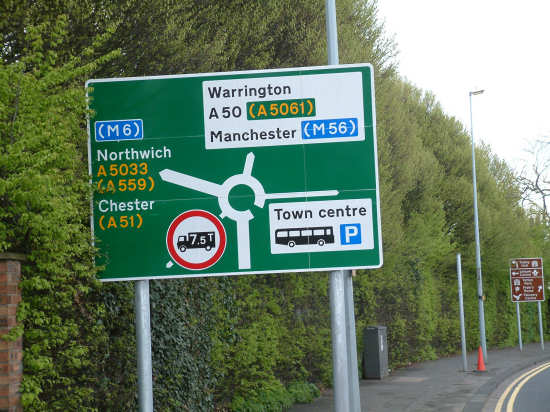
The broad lines on this sign show that the main route through the
roundabout is the road leading to Northwich and Chester
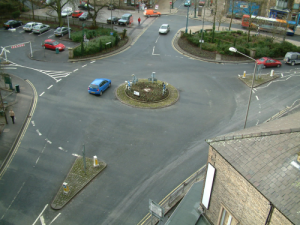
The routine for approaching roundabouts is the same as for any other junction.
However, because many roundabouts have an open view, you can make an early decision about whether to stop or go.
It's essential to keep your eyes moving as you approach to scan the road for a safe gap. Scanning will also help to ensure that you stay in a good position on the road. As with other junctions, the key to doing this is getting your speed right on the approach.
Your first warning of a roundabout on busier roads will often be a direction sign similar to those in this lesson.
There might not be a direction sign on quieter roads, but there will usually be a roundabout warning sign.
After checking your mirrors and giving a signal (if required), you need to ensure that you are in the correct lane (explained later). There will sometimes be warning signs telling you which lane to select.
The easiest way to spot your gap is to concentrate on the vehicle you wish to follow. To do this, you will be looking for vehicles coming around the roundabout with gaps behind them. Focus on the gap. That way, you will be ready to move into the roundabout as soon as it is safe.
Start looking for your gap early. If the driver behind you sees a gap and you don't, they might not be expecting you to stop!
Another critical point is that you need to be making your decision to go or stop at least three to four car lengths before you arrive - and even earlier on high-speed roads.
The early decision is necessary to adjust your speed if you intend to 'go' or give plenty of warning to the following traffic if you intend to stop.
Start looking for your gap early. If the driver behind you spots a gap and you don't, he might not be expecting you to stop!
The easiest way to spot your gap is to concentrate on the vehicle that you wish to follow - to do this you will be looking for vehicles coming around the roundabout with gaps behind them. Focus on the gap that way you will be ready to move into the roundabout as soon as it is safe to do so.
Another important point is that you need to be making your decision to go or stop at least three to four car lengths before you arrive - further back still on faster roads.
The early decision is necessary so that you can adjust your speed if you intend to 'go' or give plenty of warning to following traffic if you intend to stop.
The safety rule applies: 'If you don't know, Don't go!'
When you have entered the roundabout, you must be aware of what other people are doing.
Cyclists and horse riders often keep to the left, even if they are going all the way round the roundabout.
The Highway Code (Rule 186) says:
You should give priority to cyclists on the roundabout. They will be travelling more slowly than motorised traffic. Give them plenty of room and do not attempt to overtake them within their lane. Allow them to move across your path as they travel around the roundabout.
Cyclists, horse riders and horse drawn vehicles may stay in the left-hand lane when they intend to continue across or around the roundabout and should signal right to show you they are not leaving the roundabout. Drivers should take extra care when entering a roundabout to ensure that they do not cut across cyclists, horse riders or horse drawn vehicles in the left-hand lane, who are continuing around the roundabout.
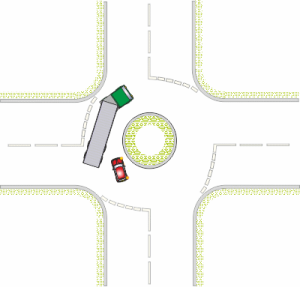 Long vehicles or vehicles towing trailers might have to take an unusual course around the roundabout. Cyclists and pedestrians are also vulnerable because the traffic often travels faster at roundabouts than at other types of junction.
Long vehicles or vehicles towing trailers might have to take an unusual course around the roundabout. Cyclists and pedestrians are also vulnerable because the traffic often travels faster at roundabouts than at other types of junction.
The red car shown in the roundabout in the illustration is heading for a potentially dangerous situation; as the lorry goes around the roundabout, the trailer will cut across its path - this is why you must always be sure to leave plenty of space.
The lorry driver also has a problem. Because truck mirrors are attached to the cab, all the driver can see in the right-hand mirror is the lorry trailer.
Most lorry drivers are alert and aware and will look back over their shoulders in this situation, but remember, it's much easier for you to see the lorry than for the lorry driver to see you.
Drivers on a roundabout they have not visited before could be unsure or confused about which exit to take. This is especially the case on large multi-lane roundabouts. If another driver seems to be hesitant or is driving erratically, give them plenty of space (you don't want to end up being involved in their accident!).
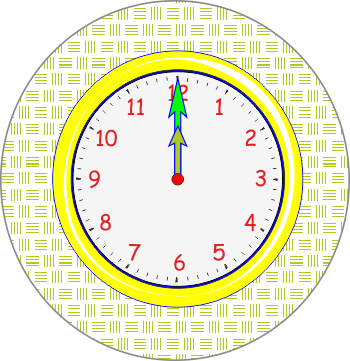 All of the 'roundabout rules' discussed here are 'general' and refer to virtually all the roundabouts you will come across.
All of the 'roundabout rules' discussed here are 'general' and refer to virtually all the roundabouts you will come across.
However…
Some roundabouts might have their own 'rules' either because of the layout or 'local driving practice'. For example, you might come across roundabouts where traffic on the roundabout has to give way to traffic entering, although these are very rare (these will be marked with signs and lines).
Your instructor will point out any 'odd' roundabouts in your area.
The 12 o'clock guideline helps you to decide which lane to use as you approach the roundabout. This is also often referred to as the 12 o'clock rule. However, you won't find it in the Highway Code.
The '12 o'clock guideline' is helpful when first learning to drive and works well for most roundabouts. However, when encountering complex, multi-lane roundabouts, you should consider it as a general guide, not an 'absolute rule'.
Always look for signs and lane markings that direct you to alternative lanes (more info below).
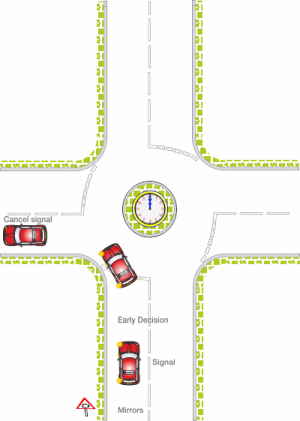 When turning left to take the first exit, you will only be in the roundabout for a short time - you need to signal your intentions early.
When turning left to take the first exit, you will only be in the roundabout for a short time - you need to signal your intentions early.
Check your mirrors, with particular emphasis on the interior mirror and left door mirror.
Approach in the left-hand lane with a left-turn signal.
Maintain your signal and position as you drive to your exit.
Cancel your signal after you leave the roundabout.
Check your mirrors again to make sure that it is safe to pick up speed
The diagram shows a roundabout with a single lane on approach - in this situation, you would position to the centre of the lane.
Where there are two or more lanes, you will almost always use the left-hand lane – the only exception being on large multi-lane roads where there could be two lanes for left-turning traffic.
Remember that you need to make an early decision. This means controlling your speed early.
In a manual car, this will often mean changing down to second gear in anticipation of a gap (if you know that you will have to stop, there is no need to change down)..
In an automatic you might need to cover the footbrake (gently rest your foot on the brake pedal) so you are ready to stop if necessary.
In an electric car the action will depend on your vehicle. With 'one pedal driving' easing off or releasing the power might be sufficient; in other electric cars, or when travelling downhill into the roundabout, you might need the footbrake.
(This control information also applies when going ahead or turning right.)
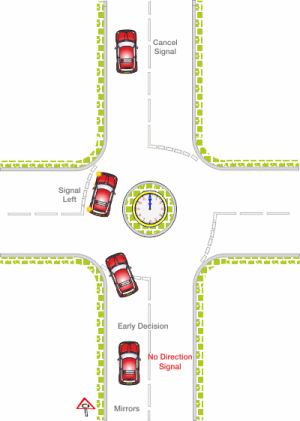 When we talk about 'going ahead', we mean taking the second exit or any exit that is not a right turn.
When we talk about 'going ahead', we mean taking the second exit or any exit that is not a right turn.
A simple method of determining whether the exit you wish to take is a right turn is to use the '12 o'clock guideline'.
Imagine that you are looking at the roundabout from above and that it forms a giant clock face.
You will always be entering the roundabout from the 6 o'clock position. If the exit you want is at or before the 12 o'clock position, you are going ahead (or turning first left); if the exit is after the 12 o'clock position, you are turning right.
As mentioned above, the 12 o'clock guideline is an excellent basic rule, but it does not apply to all roundabouts. Always look for signs or markings that suggest a different lane - local knowledge will also help.
When going ahead, you won't give a direction signal on approach - but you will need to signal to leave the roundabout.
The roundabout illustration above shows just one lane on approach – as with the left turn, you would position to the centre of the lane.
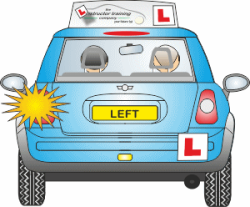 Take care not to confuse following drivers or, more importantly, drivers entering the roundabout.
Take care not to confuse following drivers or, more importantly, drivers entering the roundabout.
If you signal too soon, drivers entering the roundabout could pull out in front of you.
If you signal too late, following drivers or pedestrians crossing the road you are turning into will not get enough warning.
The DVSA advises that you should signal after you have passed the exit before the one you intend to take - but if taken too literally, this can be too late on some occasions.
Your driving instructor will help you determine the best signal timing based on the conditions and road layout; you will soon be able to judge for yourself. Whenever you signal, remember that it is essential to follow the Mirrors, Signal Manoeuvre routine.
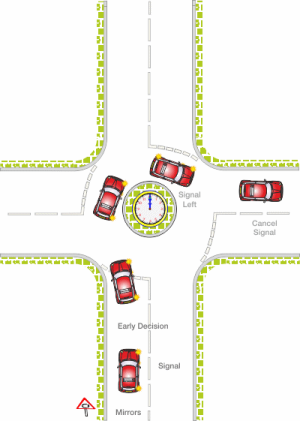
A right turn is any exit beyond '12 o'clock' on our giant roundabout clock face.
When turning right using the 12 o'clock guideline, you will use the right-hand lane. However, remember that there may be other options on large or complex roundabouts, and the right-hand lane might not be appropriate.
Use your hazard routine early to get into position.
Keep your right-lane position in the roundabout until you pass the exit before the one you want to take, then signal left and start to move across to the exit on the left.
Make full use of mirrors before moving back to the left - especially the nearside door mirror.
Some instructors also recommend a quick shoulder check to the left to ensure that there is nothing in your left blind spot - if you make a shoulder check, be careful to ensure that it doesn't affect your steering.
Check your mirrors with particular emphasis on the interior mirror and right door mirror.
This roundabout illustration shows just one lane on approach - in this instance you would position to the centre of the lane as you go around to the right.
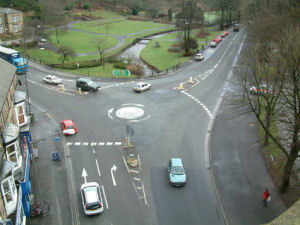
Most mini-roundabouts are painted on the road surface. Some are slightly raised, forming a circular hump in the road. Others are made from a different surface material, such as 'block paving'.
Because mini-roundabouts are smaller than larger roundabouts, there is less space to manoeuvre and less time to signal. But they still follow the same rules.
There will often be a warning sign on the approach to the mini-roundabout and then a blue circular mini-roundabout sign at the location of the roundabout.
The blue circular sign is a 'must do' compulsory sign. It tells you that you have to drive around the roundabout.
As a car driver, you should easily be able to drive around the roundabout - in fact, it is a legal requirement to do so, But larger vehicles such as lorries or vehicles towing trailers might not be able to do this. This means that you must take extra care when you meet large vehicles at mini-roundabouts.
The diagram shows the path a large articulated lorry might take.
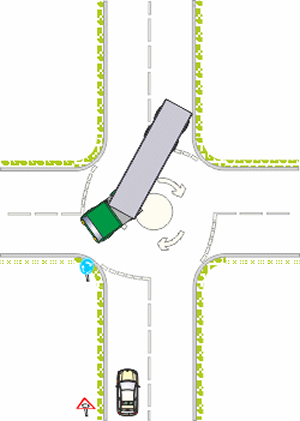 You must also watch out for vehicles doing U-turns; they can surprise you if you are not anticipating their actions!
You must also watch out for vehicles doing U-turns; they can surprise you if you are not anticipating their actions!
Mini-roundabouts sometimes come in pairs or, as you will see in the last video in this lesson, in greater numbers!
Double mini-roundabouts are typically used in places where there was once a busy staggered crossroad.
At first, double roundabouts can look quite complicated, but they are easy to deal with if you follow the rules. Simply treat each roundabout separately.
The diagrams below show a driver entering a double mini-roundabout.
At the first roundabout (1), she is cautious because the driver in the green car is not signalling.
After giving way to the green car, she negotiates the second roundabout as a separate junction where she gives way to the blue car (which gives a clear, correct signal).
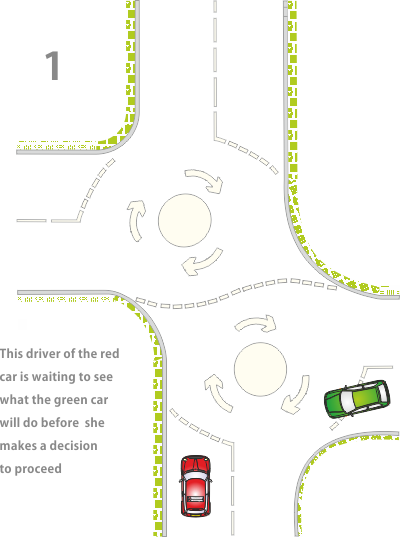
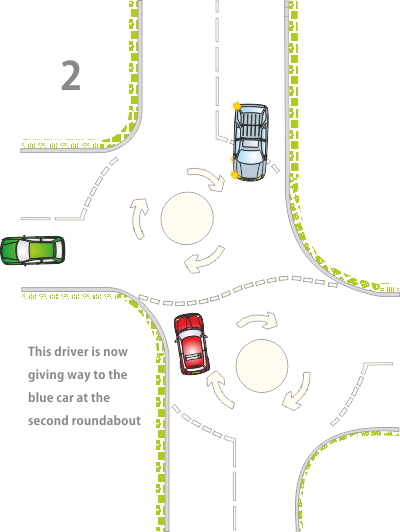

Larger roundabouts come in all shapes and sizes, ranging from the 'Magic Roundabouts' in Swindon and Hemel Hempstead (no, not like the Magic Roundabout in the picture) to large 'spiral' roundabouts at motorway intersections and other large junctions.
Whatever type of roundabout you are approaching, the starting point is to assume the standard rules from this lesson and then look for signs or traffic movements that might suggest a local variation.
Where there are more than two lanes at a roundabout, the left lane is often for turning left only. On some rarer occasions, there may be two lanes for turning right - look for signs and markings.
The diagram shows that the main road through the roundabout is the dual-carriageway.
This is an example of a roundabout where the 12 o'clock guideline might not be appropriate - you would probably use the left lane to follow the dual-carriageway, even though it is slightly beyond 12 o'clock.
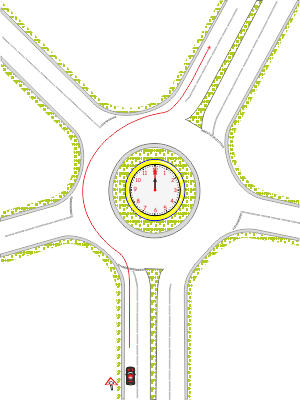 Looking at the direction or information signs on the approach to roundabouts will help you decide where to position and which lane to choose.
Looking at the direction or information signs on the approach to roundabouts will help you decide where to position and which lane to choose.
If you are unsure which exit you want or which lane to select on the approach to a large roundabout, take up a right-turn position and do a complete circuit of the roundabout.
By using the right-hand lane and going all the way around the roundabout, you can check the layout and look for signs - taking your exit on the second (or third!) pass. If you do this, always make sure that you exit safely. Never make sudden decisions - you can always go around again to plan your route.
Spiral roundabouts are becoming more common at large multi-lane junctions.
After entering the roundabout, the lane markings guide you to your exit. The trick is always to be aware of the markings ahead of you - however, a word of caution...
It's easy to concentrate so hard on the surface markings that your observation becomes 'short', and there is a danger of missing other vital information, for example, the actions of other drivers. To avoid this, get into the habit of keeping your eyes moving to scan for markings, signs and traffic movement.
At first, some people feel that spiral roundabouts are complicated - but the opposite should be the case if you enter the roundabout in the correct lane and then follow the markings.
Ask your instructor if there are any spiral roundabouts in your area.
You can see more roundabout videos in the Driving Test Success practical driving app. (Google Play | App Store - appstore practical videos available as an in app purchase in the 4 in 1 kit)>
There are a few 'multiple roundabouts' around the UK. The most famous are probably the ones in Swindon and Hemel Hempstead.
What makes these junctions different is that rather than one large roundabout, they are made up of a cluster of mini-roundabouts. When you encounter junctions like these, you deal with each mini-roundabout separately - as you would with a double mini-roundabout.
The video below shows the famous Swindon roundabouts - as viewed by a UK visitor.
 Click here to complete the quiz for this lesson
Click here to complete the quiz for this lesson
(The page will open in a new window/tab)
You will find references for the answers in this lesson.
You can check your answers as you go along, or complete the full quiz before checking.
Leaving the check to the end is a good way to test yourself.
When you check or review your answers you will get a brief explanation of the answer.
Good Luck!